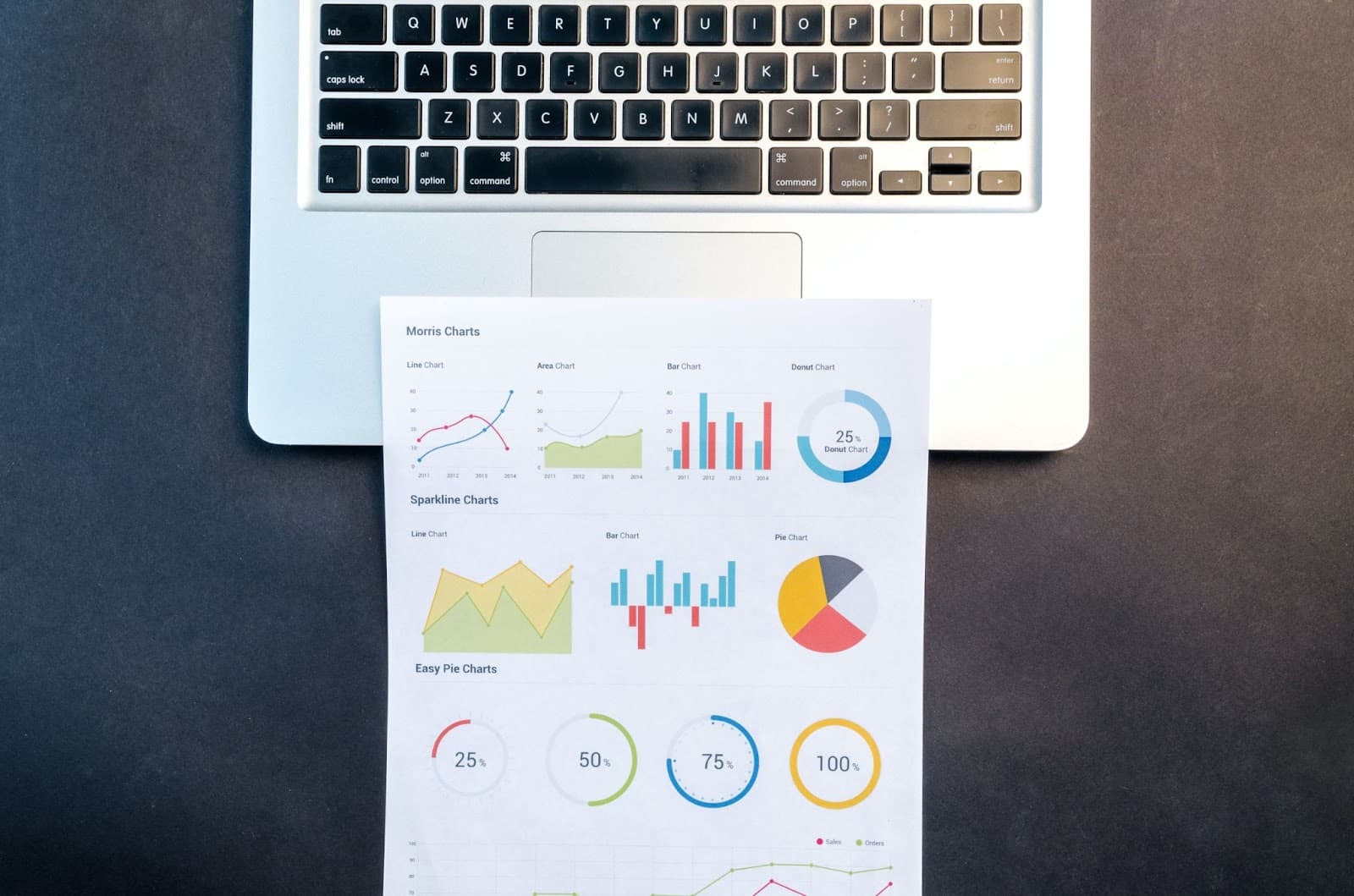🌍 All
About us
Digitalization
News
Startups
Development
Design
Everything You Should Know About Big Data Analysis
David Adamick
Sep 14, 2023・12 min read
Table of Content
What Is Big Data?
Main Objectives of Big Data Analytics
Big Data Categories
What Is Big Data Analytics?
Why is Big Data Important?
The Big Data Analytics - 4 Steps
Types of Data Analysis
The ‘5 Vs’ of Big Data Analytics
Big Data Analytics for Technology
Big Data Uses - Examples
The Challenges of Big Data
Startup House Software Development for Big Data Analytics
You may be familiar with British mathematician Clive Humby’s maxim that ‘data is the new oil’. Put another way, that data greases the axel the digital world turns on. Indeed it does. And unquestionably, two things data has done over the past several years is increase in size and speed.
So, it’s no surprise the term ‘Big Data’ has since developed in common usage to reflect this increase. It’s also no surprise when witnessing the increase in value of big data analytics when it comes to businesses gaining advantage in their respective marketplaces.
In this blog, we’re going to explore this world of big data and some of its core data integration concepts. We’ll understand what it is more specifically, and learn how in today’s data-charged environs, businesses and organizations must learn to leverage big data analytics. We’ll see just how crucial it is that they understand how this leveraging impacts leading industries.
What Is  Big Data?
Big Data?
First of all, ‘big’ doesn’t quite describe it. Whereas gargantuan is closer to the mark. Such are the volumes of data generated every day. Whether by mobile app, online purchase, social media tag, email engagement, marketing and supply chain activities – the sources are countless – such are the volumes to which the all-encompassing term ‘Big Data’ refers.
Sets of data so massive and complex, they’re too much for traditional data processing and management applications. And in today’s landscape, it is the gathering, analysis and storage of this digital information that has become an indispensable part of improving a company’s business operations.
 Main Objectives of Big Data Analytics
Main Objectives of Big Data Analytics
Essentially, big data analytics seeks to use numbers to tell a narrative. In this way, an organization can collect, store, structure and analyze huge amounts of data to solve specific problems. As a data driven approach to understanding a business, big data is analytics can construct predictive models and anticipate future trends.
Big Data Categories
Under the umbrella of this all-encompassing term, Big Data is divided into three categories:
Structured Data
Big Data in its ideal form. Ideal because of its certain predefined organizational properties, and in that it features in structured or tabular schema. This allows for easier to analysis and sorting.
Moreover, this predefined nature renders each field as discrete and therefore accessible separately or in tandem with data from other fields. This in turn renders structured data extremely valuable and makes possible the quick collection of data from other locations in a database.
Unstructured Data
As the category name defines it, here is information with no predefined conceptual definitions. Info that cannot easily be interpreted or analyzed by standard databases or data models. Here, too, is what makes up the majority of Big Data’s volume. This includes dates, numbers, facts, video and audio files, mobile activity, satellite imagery and No-SLQ databases.
Semi-structured Data
A hybrid of the two above. An inheritance of structured data characteristics, however also with information lacking in definite structure and therefore not conforming with traditional databases. Nor with formal structures of data models. JSON and XML are typical examples.

What Is  Big Data Analytics?
Big Data Analytics?
So, whether structured, unstructured or semi-structured, Big Data’s of no use unless analyzed. Which means deciphering what your data is trying to tell you. Which means uncovering the customer and market trends, patterns, preferences, insights and correlations that lurk in raw data so that you can make more accurate, data-informed decisions for your business.
Why is Big Data Important?
Because in our digital world of speedier and speedier transactions, customers develop ever instantaneous expectations. And as these transactions accumulate data just as quickly, businesses need to put this information to productive use in real-time so as to gain a purview of their target audience. Businesses that fail to do so run a much higher risk of customer churn.
Let’s take a closer look at some the uses of Big Data:
Business intelligence:
A term developed to describe the processing, analysis and application of big data for the advantage of an organization. An advantage that’s almost impossible to gain in today’s modern markets without this business intelligence. For without business intelligence, that organization cannot monitor and predict activity so that its big data may function on behalf of its products.
Innovation:
From the big data analyses intrinsic to good business intelligence are more innovative uses of this big data. Where it can be used to inform creative products and new tools to market. For example, these customized products and/or advertisements may be driven by data on demographics, georgraphics or climate patterns, and all based on the many interactions and anomalies that occur within an industry and its market – all aimed at maximizing profit potential.
Lowered Cost of Ownership:
Big data analysis can also uncover where an organization’s resources are not being used to their full potential. This is where IT personnel evaluate operations according annual contracts, licencing and overheads. Whereby insights gained enable managers to keep budgets sufficiently flexible for working in a modern environment.

The Big Data Analytics - 4 Steps
The Big Data anlaylics involve the collection, processing, cleaning and analysis of data sets to render them applicable for some of the uses as described above.
Data Collecting
Whether it be for structure, unstructured or semi-structured, the range of sources from which an organization will collect data is vast, comprising everything from mobile apps to cloud storge to IoT sensors to online purchasing. Once gathered, structured data will be typically stored in a data warehouse, whereas unstructured (‘raw’) data, owing to its diversity and over-complexity, will go into a data lake.
Data Warehouse vs. Data Lake
Big Data accessed from either of the sources cited above – the names of which are often used interchangeably, despite their different functions.
Both are used as Big Data repositories. However, a data lake is a pool of raw, easily-updated data whose purpose is yet to be defined. On the other hand, a data warehouse is where processed, structured data is kept for accessing via business intelligence tools and solutions, where modifications to this data are not as easily achieved and may be costly.
Data Processing
There are two main methods of data processing, stream processing and batch processing.
Batch processing vs. Stream processing
As it sounds, ‘batch processing’ requires that large data volumes be collected then processed offline on an incremental, segment-by-segment basis, often at regular intervals.
In stream processing, data is processed as it is being generated and integrated into the system, all in real-time. It is therefore processed as a continuous ‘stream,’ yielding results almost instantaneously.
Data Cleaning
For the best results when working with data, it is essential that it be correctly formatted, where all duplicative or irrelevant data is discarded or accounted for. In other words, data big or small must be ‘cleaned,’ otherwise it may lead to inaccurate or misleading insights being drawn.
More specifically, this means restructuring and combining multiple sets of data for analysis. Transforming data structure such as its rows, columns, types and values, for example. Here, process speed and efficiency is directly correlated to the time taken to generate insight into the data. Understanding data scope during analysis and the changes made thereto can accelerate the process as a whole.
Conducting Data Analysis
For conducting big data analysis, there are a number of tools to choose from. However, they are tools that are used in combination so that the entire process of collecting, processing, cleansing and analysis may be performed.
Among the more popular tools are:
Tools for Big Data Analytics
NoSQL data bases: non-relational data management systems not requiring a fixed scheme and ones which can deal with a variety of data models. They’re great options for handling big, raw, unstructured data.
Hadoop: an open-source framework for storing and processing large datasets on clusters of commodity hardware. It’s free, and has the capacity to deal with large amounts of structured and unstructured data making it a valuable asset for any operation.
MapReduce: serves two functions as an essential component to the Hadoop framework: mapping and reducing. Mapping filters data to various nodes within the cluster and reducing organizes and reduces the results from each node to answer a query.
YARN: a cluster management technology to aid in job scheduling and resource management in the cluster. YARN stands for ‘Yet Another Resource Negotiator’ and is another component of second-generation Hadoop.
Tableau: an end-to-end data analytics platform for data preparation, analysis, collaboration and the sharing of insights that a volume of big data may generate. With Tableau, one can ask new questions of given data by way of self-service visual analysis, and share those insights across an organization.
Spark: another open source cluster computing framework and one with the capacity for both batch and streaming processing. Here, implicit data parallelism and fault tolerance are used to provide an interface for programming entire clusters.

Types of Data Analysis
Using some of the tools listed above, more specific objectives can then be pursued depending on an organization’s requirements.
Data Mining
The processing and analysis of data a business will perform to identify relationships and patterns to solve particular problems. Using certain techniques and tools, organizations can anticipate future trends and better inform the decisions they make.
Predictive Analytics
A branch of advanced analytics that combines historical data, statistical modeling, machine learning and data mining for the purpose of predicting future outcomes. Predictive analytics are used to find patterns in data to identify opportunities and risks and are commonly associated with big data and data science.
AI
In its most basic form, a field combining computer science and datasets for the purpose of solving problems. It also involves more specific disciplines in machine learning and deep learning (see below) comprising AI algorithms for creating predictive or classifying systems based on input data.
Machine Learning
A branch of AI focusing more specifically on the use of data and algorithms to imitate the human learning process and thereby continuously improve its accuracy.
Deep Learning
A neural network with three or more layers and subset of machine learning. These networks look to simulate human brain behavior, enabling it to ‘learn’ from large volumes of data. Additional network layers help optimize and refine accuracy when generating aproximate predictions.
Text Mining
Also referred to as ‘text analytics’, text mining is an AI technology that uses natural language processing (NLP) to change unstructured document texts and databases into standardized, structured data that can be analyzed or drive machine learning algorithms.
Facts, relationships and assertions that would otherwise stay lost in a mass of textual big data are instead identified by text mining. This information is then extracted and converted into structured form, be it HTML tables, mind maps, charts, diagrams etc.
Data Visualization Tools
Software applications used to structure information in a visual format for data analysis purposes. By sifting through large volumes of data and presenting only their most relevant aspects, these apps make working with and understanding data much easier. As such, data vizualisation tools enable their users to make data-driven decisions far more promptly.
Business Intelligence Software
Software that processes and presents business data in more  user-friendly views such as reports, dashboards, charts and graphs. With BI tools, business users can access historical, current, third-party, in-house and semi- and unstructured data such as social media to analyze and gain insights into how the business is performing.
user-friendly views such as reports, dashboards, charts and graphs. With BI tools, business users can access historical, current, third-party, in-house and semi- and unstructured data such as social media to analyze and gain insights into how the business is performing.

The ‘5 Vs’ of Big Data Analytics
Industry experts tend to qualify big data according to the ‘5 Vs’ which are typically considered on an individual basis and by how each relates and interacts with the others.
Volume - Size matters. For this is the key feature of any dataset. Here, massive volumes of data require advanced processing technology – technology far beyond a desktop CPU. Here, then, is massive potential for analyses and pattern recognition, where data volumes occupy the realms of petabytes and exabytes.
Variety - The varying formats of data and how they’re organized and readied for processing. In other words, data that can be collected, stored and analyzed.
Velocity - Given that data accumulates at varying rates, this determines whether it’s classified as ‘big’ or ‘regular’ data. Therefore, systems must have the capacity to take on both the pace and volume of data accrued so that they can process and evaluate this data in real-time. Greater speed means greater data volume.
Veracity - Data must have integrity. When the trustworthiness and reliability of big data is thrown into question, so is that data’s value. This is particularly true when data is updated in real-time; when data authenticity requires verification at every level of collection and processing.
Value - Where ‘veracity’ ultimately leads. It’s not just the volume of data that is processed then stored, but indeed the data’s degree of reliability – its ‘value’. Data value is therefore directly reflected in the profitability potential of the insights it provides.
Big Data Analytics for Technology
Though it may seem redundant to say big data tech is changing technology, it is doing so in very immediate and physical ways.
Breakthroughs in multi-processing and the power to store, process, and move vast amounts of data is slowly phasing out physical network infrastructures like server banks, switches, load balancers, and more.
Big data analytics now plays a central role in building, securing, and optimizing the virtual layers that will affect applications and traffic, providing both increased training challenges and limitless opportunities to secure and scale network capabilities.
Organizations’ growing ability to leverage business big data analytics will evolve as quickly as technology itself, and almost every industry will need to adapt or fall behind in the race for modern market share.
Big Data Uses - Examples
As you’ve likely gathered by now, no data, no insights. No insights, no business intelligence. No business intelligence… you get the idea. So, to enhance this intelligence, an organization will commonly use data at its disposal for the following purposes:
Understanding Customer Behavior
For a business to truly understand its customers it must therefore understand their behaviors. It’s a crucial obligation. Because a better understanding of a specific audience is how a business more clearly identifies the needs of that audience, thereby enabling it to more effectively meet those needs.
Whether through the data analysis of customer demographics, age group, geographics, churn rates etc., establishing a solid comprehension of what customers think and feel affords a business the insights required for tailoring relevant products and services. In turn, this will optimize that business’s chances of gaining an equally solid customer retention rate.
Problem Solving
With data analysis, companies can assess the health of their processes and systems. This is particularly crucial when sales are lagging or when a product is not performing as intended. Through data analysis, an organization can gain both hindsight and foresight.
With hindsight, data review may reveal where and when these periods of weakness occur. A clearer understanding of where processes are failing presents opportunities for solutions to be applied.
Because data analysis enables the assessment of these same processes, this means that going forward, businesses can more effectively implement quality control measures and thereby anticipate and respond to problems before those problems can conflate.
Informed Decision Making
Proper analysis of quality data empowers company directors to take more accurate decisions about where that company should go. Because data is both knowledge and evidence, it gives leaders greater capacity for justifying their decisions whilst reducing risk. Decisions based on facts instead of intuition.
A Clearer Understanding of Performance
For business leaders to truly grasp how their company aspects are performing against respective targets, it is crucial that they engage data analysis. Here is where accurate insights are gained. With these insights and clarity of understanding, businesses can more effectively manage risk, supply chains, product development and price optimization.
 Streamlining Processes
Streamlining Processes
Data is integral to the optimization of company resources and the effective minimization of their waste. With business analytics, leaders gain a more topographic view of systems and processes and thus a heightened awareness of what weaknesses, obstacles and inefficiencies need to be addressed.
Isolating such inefficiencies is the first step toward a more streamlined and productive operation.

 The Challenges of Big Data
The Challenges of Big Data
The benefits of big data analytics are as numerous as they are irrefutable. Such that its application by any business would seem indispensable to that business’s survival. But despite these benefits, big data continues to present challenges.
Among these concerns are privacy and security, business user accessibility, and ensuring the right solution is chosen so that a business may exploit the full potential of incoming data.
Therefore, businesses ought to consider the following:
Data quality maintenance – increasing volumes of data also mean an increasing length of time a business will spend cleansing this data of duplicates, errors, absences, conflicts, and inconsistencies.
Data accessibility – with this steady increase, too, comes an increasing difficulty in collecting and processing data. So, organizations must ensure that data is convenient and easy to use at all skill levels.
Data security – it also means issues of privacy and security arise, thus obliging an organization toward greater compliance and tighter data processing procedures.
Choosing the right tools – amidst the continual development of new technologies for processing and analyzing data, companies still must choose that which best suits its existing ecosystems and fulfils its particular needs. Ideally, a solution flexible enough to accommodate future infrastructural changes.
Startup House Software Development  for Big Data Analytics
for Big Data Analytics
Big data shows no sign of doing anything but get bigger. And more useful. Meaning your business must first have the flexibility to connect to data promptly and consolidate it. So, if your digital product needs integration with the increasingly indispensable analytics platforms that enable this, Startup House can help.
As highly experienced software development professionals, not only do we offer superior services in product development and digital solutions, but can ensure your product is equipped with the right data processing tools.
Doing so will find your product seamlessly complemented with the best means of identifying what should be measured, why and how. With this data collected and analyzed, you’ll then be clearer on who your users are, how they behave, and how they may do so in future. Your insights thereby gained will better inform your decisions and ensure you’ve optimized this future.
If you’d like to find out more about our product development services and what data analytics facilities we can offer, don’t hesitate to reach out. Let’s talk!

 Don't miss a beat - subscribe to our newsletter
Don't miss a beat - subscribe to our newsletterYou may also  like...
like...

Top 25 Data Company Solutions for 2025
In a world where data is the new oil, choosing the right data provider can give your business a serious edge. From finance and healthcare to marketing, these 25 top data company solutions for 2025 offer powerful ways to analyze, interpret, and act on information. Explore how the best in the industry are helping businesses make smarter, faster, and more informed decisions
Alexander Stasiak
Jun 20, 2025・9 min read

Firebase and AWS Amplify: Which is the Right Choice for Your App Development Needs?
Firebase and AWS Amplify are leading platforms for mobile and web applications. Firebase excels in ease of use, real-time database capabilities, and Google integration. AWS Amplify offers scalability, backend services, and robust AWS infrastructure, making it ideal for complex, cloud-based apps.
Marek Majdak
Nov 21, 2024・9 min read

How to Dump and Restore a PostgreSQL Database
Dumping and restoring PostgreSQL databases is critical for backups and migrations. This guide covers using pg_dump for database backups and pg_restore to restore data, ensuring smooth and secure database management.
Marek Pałys
Jul 08, 2024・5 min read




